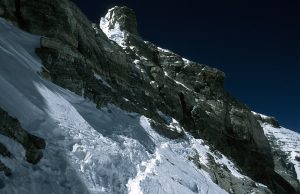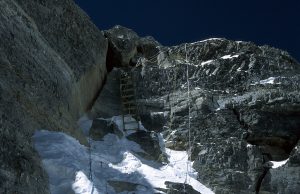Climbing the Second Step – Is the Mystery finally solved?
The central issue in the debate about whether Mallory & Irvine could have reached the summit in 1924 had been the question if they had been able to climb the crux of the Northeast Ridge, the Second Step at c. 8600 m/28,200 ft. (see The Second Step, © Theo Fritsche; from “Tatort Mount Everest”, p. 157)
The issue has been extensively covered in climbing literature (e.g. Detectives on Everest, p. 123f., and Tatort Mount Everest, pp. 173-185ff.) and on the internet, so this paper will again focus on the bare essentials:
- According to climbers’ testimonies, the Second Step has seen up to four (4) “free” ascents over the years, i.e. without the ladder placed on the headwall by the Chinese in 1975 (see The Second Step headwall, © Theo Fritsche; from “Tatort Mount Everest”, p. 175) and therefore under similar conditions as during Mallory & Irvine’s climb in 1924:
– By Catalan Oscar Cadiach in 1985, climbing on lead;
– by Austrian Theo Fritsche in 2001, climbing solo;
– by Russian Nickolay Totmjanin in 2003, exact style unknown; and
– by American Conrad Anker and Briton Leo Houlding in 2007, climbing as a roped party.
Only verbal testimonies exist as proof of the first three ascents (although Totmjanin probably had several eyewitnesses), while the fourth ascent by Anker & Houlding has been extensively covered on film and still photographs.
- Cadiach rated the headwall crux pitch UIAA V+ (5.7-5.8); Fritsche between IV+ and V- (5.6), with the last moves probably in the V+ (5.7-5.8) range; Conrad Anker is on record with ratings between 5.8 and 5.10 (V+-VI+), while Leo Houlding, after seconding the pitch, rated it 5.9 (VI). No rating is documented from Totmjanin.
The climbers who succeeded in a free ascent of the Second Step were afterwards mostly optimistic about Mallory & Irvine’s ability to have overcome the pitch in 1924 (no opinon of Totmjanin is on record so far). Tempting as this might be, these opinions can hardly be considered “evidence” – they only show that the five climbers in question were able to climb the Second Step under similar conditions as in 1924.
Final proof for a successful ascent by Mallory & Irvine can only come through the discovery of conclusive traces above the Second Step or a picture from one of their cameras showing the terrain above the step.
In November 2010 I had the opportunity (together with two colleagues, one of them an experienced rock climber) to watch the movie The Wildest Dream, starring Conrad Anker and Leo Houlding, which features their free ascent of the Second Step.
When we watched the respective sequences of the movie, we were unanimously surprised – almost shocked even – how deceptively easy the crux looks on film. The headwall pitch is just four or five moves long (which can also be deduced from a still image in the accompanying book, The Wildest Dream, between p. 152-153), has positive incut holds and might even be slightly less than vertical. Anker was able to do a no-hand rest before exiting onto the ledge at the top of the pitch.
All in all, after watching Anker’s free-climb, it suddenly did no longer seem such a long shot that Odell had seen Mallory and Irvine climbing the Second Step headwall with “alacrity” and within the time of his sighting.
Consider also the opinion of my expedition colleague, Jake Norton, who knows the Second Step
firsthand: http://mountainworldproductions.com/wp/2011/03/george-mallory-and-the-second-step-a-
red-herring.html
“I [point out] the oft-forgotten but previously popular technique of courte-échelle. Basically, a lead climber would stand on the shoulders – and even head – of another to tackle a short-but-difficult section of rock. […] The photo I just re-discovered from 1999 clearly shows that had Dave Hahn moved upward to the top of the snow bench and given Conrad Anker a courte-échelle, Conrad would have been able to reach the easier rock of the upper Second Step and probably pull over the top. […] That’s exactly what Qu Yinhua did on the Chinese expedition in 1960. And, I believe, it is likely what George Mallory and Andrew Irvine did on June 8, 1924.
While free-climbing the Second Step is an amazing, impressive feat, it’s perhaps not relevant to the question of Mallory and Irvine’s attempt on the summit in 1924.”

